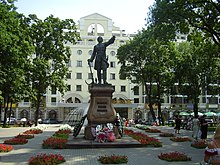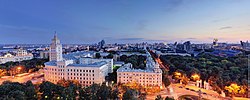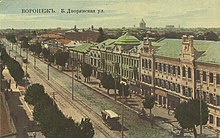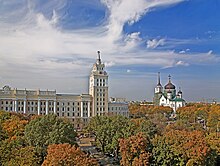Voronezh
| city
Voronezh
Воронеж
|
|||||||||||||||||||||||||||||||||||||||||||
|
|||||||||||||||||||||||||||||||||||||||||||
|
|||||||||||||||||||||||||||||||||||||||||||
| List of cities in Russia | |||||||||||||||||||||||||||||||||||||||||||
Voronezh ( Russian Воронеж ( ), scientific transliteration Voronež ) is the capital of the Voronezh Oblast in Russia . In the last census it had 889,680 inhabitants (October 14, 2010; among other things, by incorporating all the surrounding villages in the urban district , the number of inhabitants rose to 1,039,801 by 2017). Voronezh ranks 14th among the largest cities in Russia and is the most important center in southern central Russia .
geography
Voronezh is about 490 km (as the crow flies ) south-southeast of Moscow and just a little east of the Central Russian Plate on the Voronezh just before its confluence with the Don .
About 300 km in the southwest is Kharkov , 500 km in the southeast of Volgograd .
climate
| Voronezh | ||||||||||||||||||||||||||||||||||||||||||||||||
|---|---|---|---|---|---|---|---|---|---|---|---|---|---|---|---|---|---|---|---|---|---|---|---|---|---|---|---|---|---|---|---|---|---|---|---|---|---|---|---|---|---|---|---|---|---|---|---|---|
| Climate diagram | ||||||||||||||||||||||||||||||||||||||||||||||||
| ||||||||||||||||||||||||||||||||||||||||||||||||
|
Average monthly temperatures and rainfall for Voronezh
Source: Roshydromet
|
|||||||||||||||||||||||||||||||||||||||||||||||||||||||||||||||||||||||||||||||||||||||||||||||||||||||||
history
Beginnings
Human settlements in today's urban area are attested by archaeological finds since the Stone Age . The name Voronezh was first mentioned in the Chronicle of Hypatius for the year 1177. In 1237 the city was destroyed by the invasion of the Mongol-Tatar armies .
etymology
There are several versions of the origin of the name. One hypothesis is the derivation of the name from the Slavic personal name Voroneg , another from the Russian (Slavic) name of " raven " (Russian ворон , woron ). Voronezh is also the hydronym for the river flowing through the city.
A comparative analysis of the name Voronezh was carried out in 2009. It included the search for etymological sources not only in Russian and Slavic, but also in other Indo-European languages according to Max Müller's nominalistic method . Accordingly, the origin of the name Voroneg and the bird woron can be related to Indo-European names such as Uranos , Varuna , Phoroneus or Bran . The comparative analysis suggests the origin of the Indo-European toponyms and hydronyms Voronezh , Varanasi , Warna , Warnow or Verona of names of ancient water deities.
Modern times
In 1586 a wooden border fortress ( Ostrog ) was built on what is now Voronezh to protect against frequent incursions by Crimean Tatars . The highest hill on the right bank of the Voronezh River was chosen as the location. From there, the plain of the left bank of the river was good and clearly visible, from where the nomads were expected to appear. After the fortress was burned down in 1590, a new, more extensive fortress was built in 1594, which still existed in the following century. The first written mention of the fortress can be found in “Dosornaja kniga” (guard book) from 1615. In the middle of the 17th century, Voronezh lost its military importance with the shifting of the border of Tsarist Russia to the south and was now the largest trading center in the Russian black earth region .
shipyard
Tsar Peter the Great founded a shipyard in the city in 1696 to build the Azov fleet , the first Russian fleet to enable the conquest of the Ottoman Azov . New production facilities were built in the city: a cannon casting factory, a cloth factory, a canvas factory, a rope factory and a leather factory. The newly formed fleet arrived over the rivers Voronezh and Don over 1000 kilometers downstream into the Azov and Black Sea and supported in the second of Azov campaigns to conquer the Turkish fortress Azov. The small settlement of Voronezh suddenly gained political importance as a result of shipbuilding, as Tsar Peter often stayed in the city to help build the fleet. Some diplomatic representatives of European states settled in Voronezh, and like in Moscow there was also a German suburb ( Sloboda ) in Voronezh . This phase only lasted until 1705, when the shipbuilding industry moved to Tavrov (located a little downstream on the left bank of the Voronezh and an independent city until it was completely destroyed by fire in 1744; today as the Tavrovo district of Voronezh). This ended the naval history of Voronezh and the city lost its importance again in the meantime, but from 1725 it served as the administrative seat of the Voronezh governorate , which emerged from the Azov governorate founded in 1708 .
19th century
In the first half of the 19th century, Voronezh became the economic and cultural center of southwestern Russia. The agro-industry (flour mills, butter factories, soap factories) and the trade in food such as baked goods, cattle, salts and wool were particularly important. The number of cultural institutions and their role in the life of the city grew. With the completion of the railway connections to Moscow in 1868 and Rostov-on-Don in 1871, the city's growth accelerated again. In 1897 Voronezh had 81,000 inhabitants, in 1913 the city population was 94,800; this made the city one of the twenty largest in Russia.
At the beginning of the 20th century, Voronezh had 1,350 industrial, craft and trading companies with a total of 10,850 employees. In the years of the Soviet Union's first five-year plans , large industrial establishments emerged. In the RSFSR , the Voronezh governorate , which had existed since 1796, was dissolved and Voronezh was then the capital of the newly formed Central Black Earth Oblast on May 14, 1928 (Zentralno-Tschernosjomnaja oblast). After this oblast was dissolved, it became the capital of Voronezh Oblast on June 13, 1934 .
Second World War
During the Second World War , the city was occupied by the Wehrmacht for 212 days from 1942 to 1943 after the Voronezh-Voroshilovgrad operation and suffered great damage. On January 25, 1943, the city was finally liberated. Around 30,000 of the city's 350,000 inhabitants died or were deported to Germany for forced labor during this time .
In Voronezh there was a prisoner of war camp 82 for German prisoners of war of the Second World War . Over 90% of the city was destroyed by the time the city was liberated.
As a memorial for peace, about 40 km southwest of Voronezh on the P 194 in Jemantscha, a war cemetery for 1,143 German soldiers from the years 1941–1945 was laid out. The names are recorded on three granite steles.
Reconstruction and the present
After the war, Voronezh was rebuilt. Although important architectural monuments such as the Nikolski Church and the Potemkin Palace from the 18th century have been reconstructed, most of the city center has been redesigned in the confectioner's style. Today Voronezh is an important center of industry, science and culture of Russia. Due to immigration and the incorporation of suburbs, the population grew to over a million people by 2016; the entire Voronezh agglomeration today has a population of around 1.3 million. The city's industrial plants manufacture machine tools, excavators, passenger planes, and mining equipment, among other things. In addition, Voronezh has established itself as an important educational center; Today there are more than a dozen colleges in the city, including seven universities, with a total of around 80,000 students, of which the Voronezh State University is the largest.
Attractions

Voronezh combines several architectural styles in its cityscape, from the governor's palace built in the Baroque style in the center to the classicism style, which is represented in the cityscape by another palace of the governor and a building by Giacomo Quarenghi . The latter was expanded after the Second World War , but the style was not changed. Everywhere in the city there are representatives of the most diverse building eras, including the Stalinist confectioner style in the theaters and the administration building of the South-East Railway or the historicism and Art Nouveau style in the Bristol Hotel from the early 20th century. In the 1980s, Lithuanian painters planned and created the puppet theater, combining architecture and painting. There are a number of classic Russian-style Orthodox churches worth seeing, such as the Dormition Church, as well as two well-known Orthodox monasteries, including a cave monastery. An excavated ancient settlement of the Alans can also be seen in a large open-air museum .
Around Voronezh there are also many relics of the spa culture and other interesting archaeological objects.
Population development
| year | Residents | Remarks |
|---|---|---|
| 1897 | 80,599 | |
| 1939 | 326.932 | and 16,623 Otroschka workers' settlement (incorporated in April 1939) |
| 1959 | 447.164 | |
| 1970 | 660.182 | |
| 1979 | 782.950 | |
| 1989 | 886.844 | |
| 2002 | 848.752 | |
| 2010 | 889.680 | |
| 2014 | 1,014,600 |
Note: census data
Voronezh has been a megacity since December 17, 2012. On that day, Yegor Dmitrievich Lopyrev, the one millionth inhabitant of the city, was born.
City structure
| Stadtrajon (Gorodskoi Rajon ) |
Russian name | Residents (October 14, 2010) |
Name meaning |
|---|---|---|---|
| Kominternovsky | Kominternovsky | 273.243 | Comintern -Rajon |
| Leninsky | Ленинский | 110.172 | Lenin Rajon |
| Levobereschny | Левобережный | 169.426 | Left Bank Raion (on the left bank of the Voronezh River ) |
| Zheleznodorozhny | Железнодорожный | 106,751 | Railway Rajon |
| Sowetski | Советский | 150.716 | Soviet bayon |
| Zentralny | Центральный | 79,372 | Zentralrajon |
On January 1, 2011, all other localities previously located on the territory of the urban district were incorporated into Voronezh, which increased the city's population by around 100,000 to just under a million. These include the urban-type settlements of Krasnolesny (5,405 inhabitants) and Somowo (13,605; both belonging to the Schelesnodorozhny rajon), the urban-type settlements of Pridonskoi (18,300) and Shilowo (7,777), the settlement of Pervoje Maja (4,900) and the village of Podkletnoye (3,386; all to Sowetski rajon), the villages Maslowka (8,447) and Nikolskoje (5,517; to Levobereschny rajon), the village of Podgornoje (9,285; to Kominternowski rajon) and 13 other smaller towns.
economy
Today Voronezh is the largest city in the southwestern black earth region and one of the country's granaries. Companies in the mechanical engineering, chemical and food industries are located here. The Il-86 and Il-96 airliners, which are still widespread in Eastern Europe, originate from Voronezh . Rocket engines, vehicle tires and agricultural equipment are also produced here on a large scale. In order to provide the factories with enough water, an artificial reservoir was built in 1972, which has since divided the city into the more industrial part on the left bank and the older part on the right bank. The construction of a thermal power station with two reactors of the type AST-500 began. In the meantime, however, this has been discontinued (see main article Voronezh nuclear heating plant ) . In the nearby town of Novovoronezh (Neu-Voronezh) there is the Novovoronesch nuclear power plant and the Novovoronesch II nuclear power plant , which has been under construction since 2007 .
The city of Voronezh was also popularly known as the " Gaza Strip " ( Gaza Strip ; can also be translated as the gas sector) due to industrial pollution . The punk band of the same name , which is based there, once sang that you won't get older than 40 there. That is perhaps a bit of an exaggeration, but much of the cityscape outside the city center is indeed industrial and accordingly heavily polluted.
traffic
Voronezh has an international airport, Voronezh Airport . The city has an inland port on the Don . It is also on the Russian M4 Don highway from Moscow to Novorossiysk . The R193 , which connects the city with Tambov , begins here . Another important trunk road is the R298 to Kursk or Borissoglebsk .
As is typical in Russia, local public transport is based on a system of city buses, trolley buses and taxi routes . The city's tram network, which went into operation in 1926, was shut down in April 2009.
Voronezh is a railway junction . The city is the administrative seat of the Southeast Regional Directorate of the Russian State Railways . The management not only operates all railway lines and the associated infrastructure in the Voronezh area, but also a rail network that is over 4000 kilometers long.
Education and culture
In Voronezh there are several cinemas, theaters, an opera and ballet theater and its own television studio.
The development of science in Voronezh began with the appearance of the first scientific journal Filologitscheskije Sapiski in 1860, the editor of which was Alexei Khovansky - since 1845 Russian teacher in the Voronezh St. Michael Cadet Corps.
There is a classic state university in Voronezh, which was based in Tartu and was moved here in 1918 after Estonia gained independence . The university is well known and students from Asia , Africa and Latin America give it an international flair. There are also numerous other universities and educational institutions. Museums and theaters complete the picture.
Further educational institutions on site:
- State universities and technical colleges based in Voronezh
- Voronezh State University
- Voronezh State University of Architecture and Construction
- Voronezh State Pedagogical University
- Voronezh State Technical University
- Voronezh State Technological Academy
- Voronezh State Forest Technology Academy
- State Kaiser Peter I Agricultural University Voronezh
- Voronezh State Art Academy
- Voronezh State N.N. Burdenko Medical Academy
- Voronezh Medical University / Voronezh Medical Academy
- Voronezh State Ballet School
- Branches of other universities
- Belgorod University branch for consumer cooperation
- Branch of the Moscow Academy of Economics and Law
- Branch of the Moscow Humanities and Economic Institute
- Branch of the Moscow State Academy of Sports
- Branch of the Russian Academy of State Service Voronezh
- Branch of the Russian State Public Technical University of Transportation
- Branch of the State Jewish Academy
- Branch of the All-Russian Remote Institute of Finance and Economics
- Branch of the Moscow State Trade University
- Other universities and institutes
- Humanities Institute Voronezh
- University of the Interior Ministry of Russia Voronezh
- Institute for Management, Marketing and Finance
- Institute for Microelectronics and Applied Physics
- Institute for Economics and Law
- Institute of Economics and Social Administration Voronezh
- International University of Computer Technologies
- International University of High Technologies
- Military Institute for Communication Electronics
- Military Technical Institute of Aviation Voronezh
- Voronezh Business School
- Economic Law Institute Voronezh
- Center for business law training at the Voronezh State Pedagogical University
Sports
The city is represented by the football club FK Fakel Voronezh in the second highest Russian league . Its home stadium is the central stadium of the trade unions , which was opened in 1930 and seats 32,750.
The HK Buran Voronezh ice hockey club, founded in 1977, takes part in the WHL and plays its home games in the LDS Jubilee .
Sister cities and partner counties
The city of Voronezh has had a partnership with the Wesermarsch district since 1989 . The partnership is maintained through regular visits by representatives from politics and administration. Another component of the partnership are annual trips by young people to the partner city or the partner district.
The city of Chongqing , People's Republic of China , has been a twin city of Voronezh since 1993.
sons and daughters of the town
Voronezh is the hometown of the Russian writer and Nobel Prize winner Ivan Bunin . The poet Ossip Mandelstam lived here in exile from 1934 to 1938 .
The sons and daughters of the city of Voronezh include a. the writers Samuil Marschak (1887–1964) and Andrei Platonow (1899–1951), history and portrait painter Nikolai Ge (1831–1894), navigator and polar explorer Valerian Albanow (1881–1919), one of the most famous and talented animal trainers of the 20th Century Anatoly Durow (1887–1928), physicist, discoverer of Cherenkov radiation and Nobel Prize winner Pavel Cherenkov (1904–1990), chairman of the KGB from 1958 to 1961 Alexander Schelepin (1918–1994), cosmonaut Konstantin Feoktistov (1926–2009 ), the correspondence chess world champions Vladimir Sagorowski (1925–1994) and Grigori Sanakojew (* 1935), actress Ija Zavvina (1936–2011), artistic gymnast and two-time Olympic champion Lyubow Burda (* 1953), water diver and eight-time Olympic champion Dmitri Sautin (* 1974), Ice hockey player Alexander Kryssanow (* 1981) and the artistic gymnast and world champion on the uneven bars Viktorija Komowa (* 1995).
Web links
- http://www.voronezh-city.ru/ Official website of Voronezh City Council (Russian)
- http://www.voronezh.net/ (Russian)
- http://iatp.vspu.ac.ru/kursant2000/san/gorod.htm Detailed description of many buildings (Russian)
- City map (Russian)
- http://www.voronezh-media.ru/
- http://www.allvrn.ru/
- The history of the city (Russian and English)
Individual evidence
- ↑ a b c d Itogi Vserossijskoj perepisi naselenija 2010 goda. Tom 1. Čislennostʹ i razmeščenie naselenija (Results of the All-Russian Census 2010. Volume 1. Number and distribution of the population). Tables 5 , pp. 12-209; 11 , pp. 312–979 (download from the website of the Federal Service for State Statistics of the Russian Federation)
- ↑ City Population - population numbers of cities in Russia
- ↑ A. Lazarew: Tajna imeni Voronezh. Voronezh, 2009.
- ↑ Maschke, Erich (ed.): On the history of the German prisoners of war of the Second World War. Verlag Ernst and Werner Gieseking, Bielefeld 1962–1977.
- ↑ Jemantscha war cemetery near Voronezh
- ↑ millionth inhabitant born in Voronezh. In: Voice of Russia . December 18, 2012, accessed December 18, 2012 .
- ↑ Родителям миллионного жителя Воронежа подарят дом или квартиру. In: RIA Novosti . December 17, 2012, Retrieved December 18, 2012 (Russian).
- ↑ Law No. 136-OS of the Voronezh Oblast of December 24, 2010
- ^ Partnership between the Wesermarsch and Voronezh
- ^ Chongqing Municipal Government










